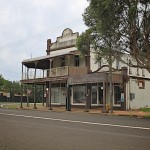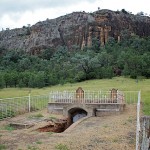Day 25 – 10,727 KM. Town 52. Today is officially the first day of autumn and the weather has turned overcast and showery on cue as I head north to the town of Boggabri.
Boggabri has proven to be a bit illusive for me as somehow I managed to miss the town when I was last in the area, so for this trip north I’ve had to cover some old ground and make a diversion to ensure I stop by. How I missed the town earlier I do not really know, but it may be because Boggabri has a history of changing location and caught me out (well thats my excuse!). Until the 1850’s the township was located 20 kilometres to the south of its present location, but relocated due to the original town being washed away in a flood. Boggabri is now the only town situated on banks of the Namoi River that does not flood.
The township itself is pleasant and comes across as very flat, as in no hills, as you drive around. There is a small shopping district, which meets the immediate needs of the locals, and a number of residential houses for the 875 people who live here, some of whom work in the local cotton industry.
I was particularly interested in visiting the nearby landmark “Gins Leap” some 5 KM to the north of the town. However, perhaps before discussing this further, it is worth mentioning an incident that happened some 270 KM further north in a small town of Mugindi in Queensland in October 1866. On a fateful day at the start of the month, a Maria Russell was handling some bulk spirits in the inn at Mungindi when they were ignited by flame from an open slush lamp. Both Maria and her 2 year old son John James Russell died in the resulting accident.
At the foot of Gins Leap a hotel and coach stop opened in 1854 known as “The Rock Inn”. Of course, this was not in reference to the music on offer, but the location of the establishment at the foot of the rocky outcrop behind it. Apparently this was a vital stopover point and prominent local landmark until its closure in around 1875 when hotels opened within the township instead. In October 1866 a man on horseback apparently called at the Rock Inn to advise the landlord and landlady Mr and Mrs Glover of the incident some 280 km to the north, as sadly the girl and baby that died was the daughter and grandson of Mr and Mrs Glover.
On hearing the news a horse team were sent to meet the coach bringing the bodies back to Boggabri and the two were later burred near to The Rock hotel. Mrs Glover died aged 76 some twenty five years later on 9 November 1891 and her husband, aged 83 died on 28 October 1892 and both were buried alongside their grandson and daughter.
In 1895 a Danish tradesman, Christy Hansen constructed the vault where the family now rest at the foot of Gins Leap along with Mary Ann Mein, a young girl employee at the Rock Inn, who died on 17 January 1858 aged 19 years. Mary Ann was buried near to the old Rock Inn, but with reconstruction of the road some years ago, the headstone was relocated to its present site.
As for Gins Leap itself, there are various local tales giving the reason for its name. Apparently the best known reason is that a young Aboriginal girl, promised to an elder of her tribe, the Kamilaroi, ran away with a young aboriginal man from another tribe. Hotly pursued by Kamilaroi tribesmen, the lovers jumped to their death from along the top of the rock.
I’m pleased to have finally found Boggabri and some of its stories but now I need to head off further north to Emmaville.


